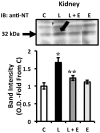Preservation of renal blood flow by the antioxidant EUK-134 in LPS-treated pigs
- PMID: 25815596
- PMCID: PMC4424988
- DOI: 10.3390/ijms16046801
Preservation of renal blood flow by the antioxidant EUK-134 in LPS-treated pigs
Abstract
Sepsis is associated with an increase in reactive oxygen species (ROS), however, the precise role of ROS in the septic process remains unknown. We hypothesized that treatment with EUK-134 (manganese-3-methoxy N,N'-bis(salicyclidene)ethylene-diamine chloride), a compound with superoxide dismutase and catalase activity, attenuates the vascular manifestations of sepsis in vivo. Pigs were instrumented to measure cardiac output and blood flow in renal, superior mesenteric and femoral arteries, and portal vein. Animals were treated with saline (control), lipopolysaccharide (LPS; 10 µg·kg-1·h-1), EUK-134, or EUK-134 plus LPS. Results show that an LPS-induced increase in pulmonary artery pressure (PAP) as well as a trend towards lower blood pressure (BP) were both attenuated by EUK-134. Renal blood flow decreased with LPS whereas superior mesenteric, portal and femoral flows did not change. Importantly, EUK-134 decreased the LPS-induced fall in renal blood flow and this was associated with a corresponding decrease in LPS-induced protein nitrotyrosinylation in the kidney. PO2, pH, base excess and systemic vascular resistance fell with LPS and were unaltered by EUK-134. EUK-134 also had no effect on LPS-associated increase in CO. Interestingly, EUK-134 alone resulted in higher CO, BP, PAP, mean circulatory filling pressure, and portal flow than controls. Taken together, these data support a protective role for EUK-134 in the renal circulation in sepsis.
Figures







References
-
- De Backer D., Scolletta S. Clinical management of the cardiovascular failure in sepsis. Curr. Vasc. Pharmacol. 2013;11:222–242. - PubMed
Publication types
MeSH terms
Substances
Grants and funding
LinkOut - more resources
Full Text Sources
Other Literature Sources
Medical
Research Materials
Miscellaneous

